Homicide in Scotland, 2014-15
Statistical bulletin on crimes of homicide recorded by the police in Scotland in 2014-15.
Commentary
Homicide cases
- Chart 1 shows the twenty year time-series in homicide cases, starting in 1995-96. Between 2013-14 and 2014-15, the number of homicide cases recorded by the police in Scotland decreased by 2% (or one case) from 60 to 59. This is the lowest number of homicide cases for a single twelve month period since 1976, the first year for which comparable data are available.
Chart 1: Cases recorded as homicide by the police, Scotland, 1995-96 to 2014-15
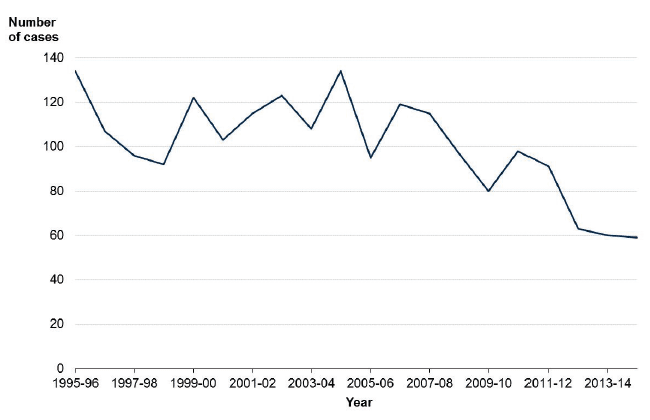
- Table 1 shows that homicide cases involving more than one victim remain rare, and none were recorded in 2014-15. In total, there were only eight homicide cases involving multiple victims between 2005-06 and 2014-15. Of the 59 homicide cases recorded in 2014-15, 22% of them involved more than one accused person. There were a total of 77 accused persons connected with the 59 recorded homicide cases.
Table 1: Summary table of homicide cases, victims and accused persons, Scotland, 2005-06 to 2014-15
| Homicide cases, victims and accused | 2005-06 | 2006-07 | 2007-08 | 2008-09 | 2009-10 | 2010-11 | 2011-12 | 2012-13 | 2013-14 | 2014-15 |
|---|---|---|---|---|---|---|---|---|---|---|
| Total number of cases | 95 | 119 | 115 | 97 | 80 | 98 | 91 | 63 | 60 | 59 |
| Cases by number of victims: | ||||||||||
| 1 | 95 | 118 | 115 | 95 | 78 | 97 | 90 | 63 | 59 | 59 |
| 2 | - | 1 | - | 2 | 2 | - | - | - | 1 | - |
| Total number of victims | 95 | 120 | 115 | 99 | 82 | 100 | 93 | 63 | 61 | 59 |
| Cases by number of accused: | ||||||||||
| 1 | 68 | 90 | 88 | 67 | 53 | 68 | 66 | 45 | 46 | 46 |
| 2 | 12 | 14 | 16 | 19 | 20 | 19 | 13 | 11 | 8 | 9 |
| 3+ | 12 | 14 | 8 | 8 | 6 | 10 | 10 | 6 | 6 | 4 |
| unsolved | 3 | 1 | 3 | 3 | 1 | 1 | 2 | 1 | - | - |
| Total number of accused | 141 | 169 | 149 | 132 | 121 | 142 | 127 | 85 | 89 | 77 |
- In 2014-15, Glasgow City local authority had the highest number of homicide cases (14). While it is important to note victims may not necessarily reside in the local authority where the homicide took place, Glasgow City has the highest proportion of all homicide cases (24% of the Scottish total in 2014-15), which is more than double its share of the population (11% of the Scottish population[1] ). Glasgow City has also witnessed a significant fall in homicides of 56% since 2005-06, contributing to half the overall national decrease.
Chart 2: Location of homicide cases, where known, Scotland, 2005-06 to 2014-15
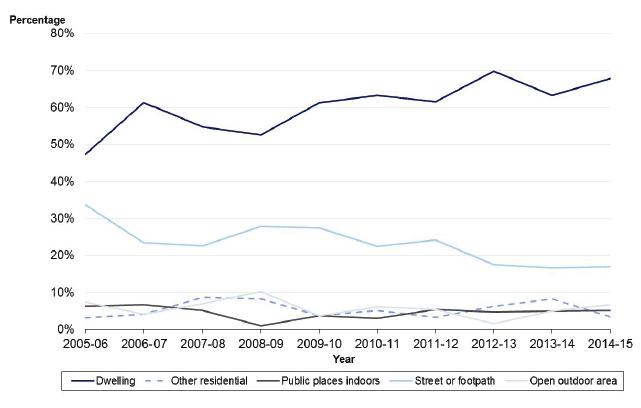
- In 2014-15, the most common location for homicides to occur was within a dwelling (68% of all cases) followed by a street or footpath (17% of all cases). In total, 71% of homicides occurred within a residential location, 24% in outdoor public places and 5% in indoor public places. Chart 2 shows the distribution of homicide cases by location between 2005-06 and 2014-15. Both the number of homicide cases in residential locations and public places have fallen since 2005-06. However, the proportion of homicide cases occurring in residential locations has increased by an average of 2.3 percentage points per year since 2005-06, and the proportion of homicide cases occurring in outdoor public places decreased by an average of 1.9 percentage points per year.
Victims of homicide
- Chart 3 shows the number of victims of homicide for the last twenty years. Between 2013-14 and 2014-15, the number of homicide victims in Scotland decreased by 3% (or 2 victims) from 61 to 59. This is the lowest number of recorded homicide victims for a single twelve month period since 1976.
Chart 3: Total Number of victims and total number of male victims, Scotland, 1995-96 to 2014-15
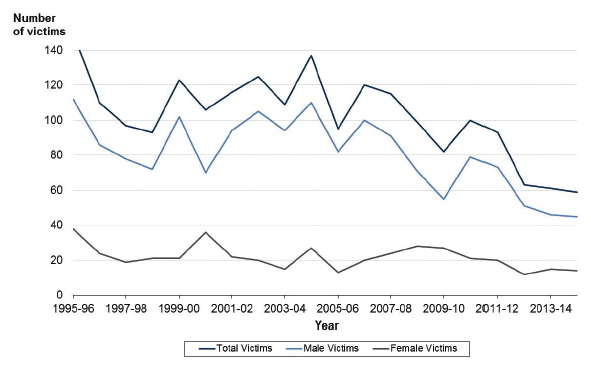
- In 2014-15, there were 45 male victims, 76% of all homicide victims. The overall homicide rate for males was 17 victims per million population, over three times the rate for females which was five victims per million population.
- Chart 4 shows that in nearly all age groups reported in this bulletin with the exception of those under 1 year and over 71 years, males have a higher victimization rates than females over the last ten years. The rate for males peaks in the 21 to 30 age group. Those in the under 1 year age group have the highest victimization rate of the female age groups, but these are relatively smaller numbers than other age groups.
Chart 4: Age profile of homicide victimisation rate by gender, Scotland, 2005-06 to 2014-15
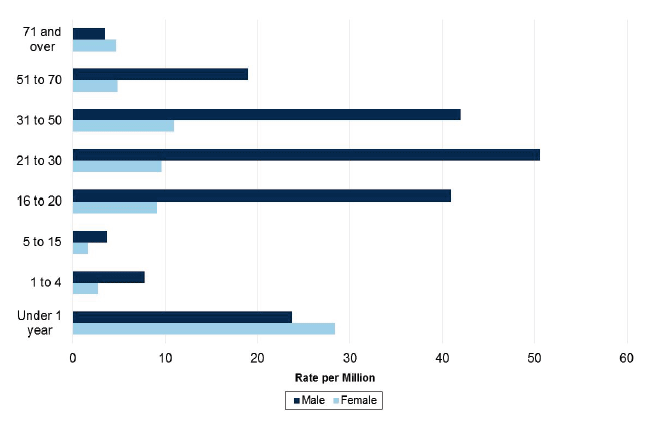
Persons accused of homicide
- Chart 5 shows the number of accused of homicide for the last 20 years. It shows that 2014-15 had the lowest number of persons accused of homicide over this time period.
- In the 59 homicide cases recorded in 2014-15, 77 persons have been accused, twelve less than in 2013-14. The vast majority of accused persons, in each year in the series, have been male. In fact, the proportion of the accused that are male has never fallen below 80% for the last ten years and was 91% in 2014-15.
Chart 5: Total number of accused and total number of male accused, Scotland, 1995-96 to 2014-15
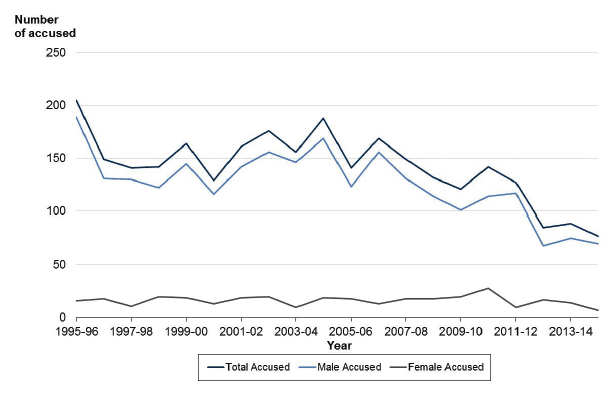
- In 2014-15, the total number of individuals accused of homicide equated to 14 per million population. This is the lowest rate recorded in the last ten years.
- The rate of accused males was highest for the 21 to 30 age group, and males aged 16 to 20 years, at 67 per million population. For females, the 21 to 30 age group was the highest rate of accused people, at 8 per million population.
- Chart 6 shows that amongst all age categories the rates of males accused of homicide per million population were considerably higher than for females in the period from 2005-06 to 2014-15. As an example of the relative number of males accused of homicide during the period, more males aged 16 to 20 years old were accused of homicide than the total number of females accused of homicide (i.e. across all age categories).
Chart 6: Person accused of homicide per million population by age and gender, Scotland, 2005-06 to 2014-15
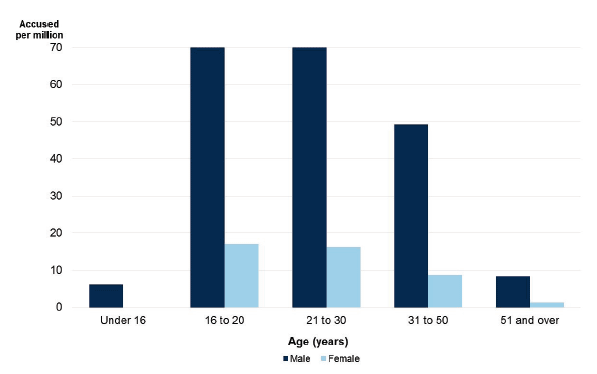
Method
- The most common main method of killing in each of the last ten years was with a sharp instrument. Of those reported to be killed with a sharp instrument, a knife was used in 82% of the cases. Shooting as the main method of killing occurred in a consistently small number of homicides over the period from 2005-06 to 2014-15.
- In 2014-15, a sharp instrument was the main method of killing for 33 (56%) of all homicide victims. Of these 33 victims, 27(82%) were killed with a knife. The next most common main method of killing, which in 2014-15 was hitting and kicking, accounted for ten (17%) of all homicide victims.
- Chart 7 shows that sharp instruments were the most common method of killing for male victims. In 2014-15, 25 (56%) of male homicide victims were killed with sharp instruments. Throughout the ten-year period females were more likely to be killed by sharp instruments as well and in 2014-15, eight (57%) female homicide victims were killed by this method.
Chart 7: Victims of homicide by main method of killing, 2005-06 to 2014-15
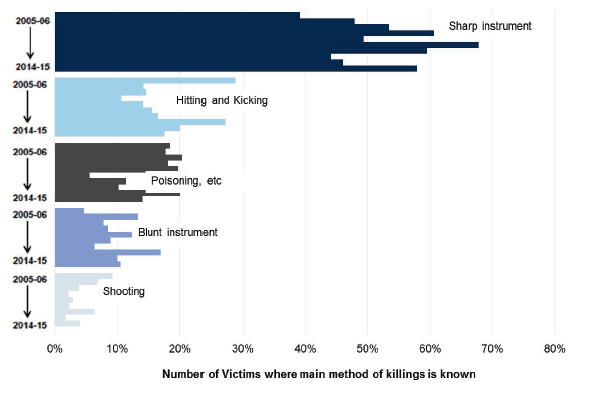
Relationship of main accused to victim
- For 46 (78%) homicide victims in 2014-15, the victim and main accused were known to each other. The victim and accused were not known to each other in 13 cases (22%). Of those cases where the victim and accused were known to each other, 39% were Acquaintances and 12% were partners or ex-partners.
- Chart 8 presents the time-series covering the last ten years in the percentage of homicides for male and female victims by their relationship to the main accused. The highest percentage of male victims was consistently those killed by an acquaintance. For female victims the largest percentage was almost always killed by a partner or ex-partner. There are greater fluctuations in the percentage of the relationships of the accused to female victims due to the smaller number of female victims compared to male victims.
- A total of 43 children under the age of 16 years were victims of homicide between 2005-06 and 2014-15 in cases where there was an accused person. Of these, 70% were killed by one of their parents. For the 14 victims aged under one year old, where there was an accused person, the main accused was a parent in all but one homicide case in that ten-year period.
Chart 8: Victims of homicide by gender and relationship to main accused, where relationship known, Scotland, 2005-06 to 2014-15
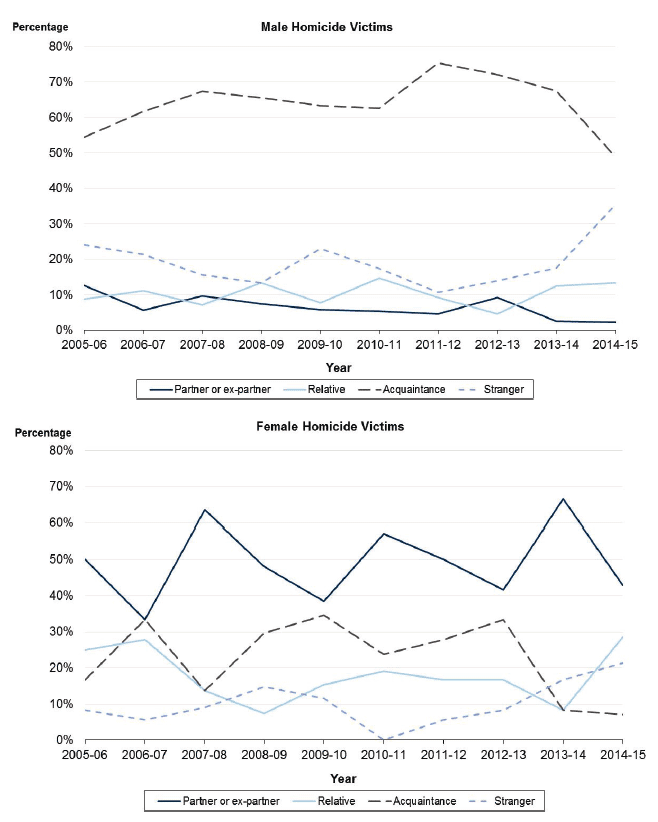
- For all homicides recorded in the last ten years, just over half (53%) of the female victims aged between 16 and 70 years were killed by their partner or ex-partner, 26% were killed by an acquaintance and 8% were killed by a stranger. For male victims aged 16 to 70 years, only 7% were killed by their partner or ex-partner. Just under two thirds (62%) of male victims aged 16 to 70 years were killed by an acquaintance and 18% were killed by a stranger.
- Of the 24 people aged over 70 who were victims of homicide in the ten year period covered by this bulletin, 16 were female and eight were male. Older people were most likely to be killed by either their son or daughter (seven victims). Of the seven victims killed by their son or daughter, six were female.
- Chart 9 shows that the majority of all homicide cases (68%) recorded between 2005-06 and 2014-15 involved males killing males. Cases where the main accused and main victim were both female accounted for just 3% of the total number of homicide cases recorded in this period.
Chart 9: Relationship between main accused and victim, where relationship known, Scotland, 2005-06 to 2014-15
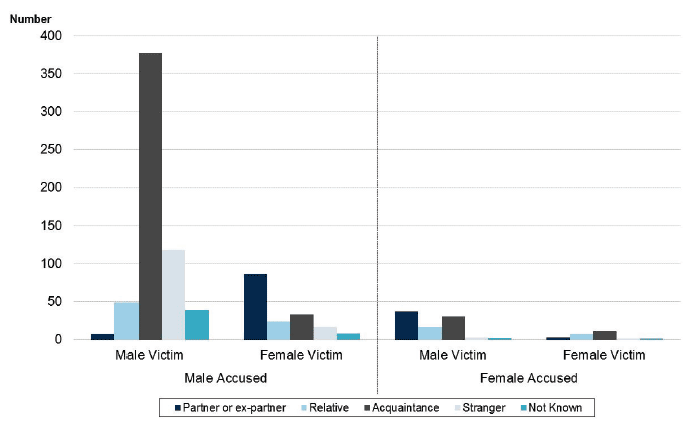
Main motive
- The most common reasons recorded for committing homicide in the ten year period between 2005-06 and 2014-15, were fight or quarrel, and rage or fury, with half (50%) of all victims killed in such circumstances. In 2014-15, this figure was 38 victims (64%), with 22 for whom the main motive was fight or quarrel.
- In 2014-15, the main motive in the killing of 36% of male victims was fight or quarrel. The next most common known motives for killing male victims was rage or fury accounting for a third (33%) of male victims. Throughout the last ten-year period, the main motive in the killing of females also tends to be fight or quarrel, and in 2014-15 when combined with rage or fury, accounted for half (50%) of all female victims.
- In the period 2005-06 to 2014-15, 81% of all female victims were killed in dwellings, compared with 54% of males. The most common set of circumstances in which females become victims of homicide are in a dwelling, in a rage or fight with a partner or ex-partner (19% of female victims). Location is less of a factor for male victims, whose killings are more typically a result of a rage or fight with an acquaintance (34% of all male victims).
- Two victims were reported to have been killed in drug-related homicide cases in 2014-15, both of which were male. None of the homicides recorded in 2014-15 were reported to have had a homophobic or racial motivation. In all homicide cases in the ten years leading up to 2014-15, 3% of all homicide cases had a homophobic or racist motivation, and for 5% of cases the motivation was unknown.
Alcohol and drug status
- Over a third (38%) of the total of 77 persons accused in homicide cases in 2014-15 were reported to have been under the influence of alcohol and/or drugs at the time of the homicide. Of these 77, 11 (14%) were under the influence of alcohol, 2 (3%) were under the influence of drugs, and 16 (21%) were both. Ten accused persons (13%) were reported to have been neither under the influence of alcohol nor drugs at the time of the homicide.
- In 2014-15, the alcohol and drug status of the accused was unknown for 38 persons, nearly half (49%) of all accused.
- In the ten year period between 2005-06 and 2014-15, around half (51%) of all accused were reported to have been under the influence of alcohol and/or drugs at the time of the homicide. This follows a similar proportion of males (51%) and females (52%). The pattern across all age groups suggest that for the accused over 16 years of age, the proportion of the accused under the influence of drugs and alcohol falls with age (e.g., 54% of accused aged between 16 to 20 years, falling to 42% for those aged 51 and over). This pattern, though, is driven by the alcohol and drug status of accused men.
- In 2014-15, 78% of cases where the main accused was under the influence of alcohol and/or drugs, the victim was also known to have been under the influence of alcohol and/or drugs. Where the main motive for a homicide was a rage or fight, only in 11% of cases was the accused not under the influence of alcohol and/or drugs.
- Chart 10 shows that over the last ten years 134 (24%) of homicides where the accused was suspected of being under the influence of alcohol occurred on a Saturday. Furthermore, nearly three fifths of those accused of homicide under the influence of alcohol (327, or 59%) occurred during the weekend as defined as Friday, Saturday and Sunday.
Chart 10: Distribution of those accused of homicide under the influence of alcohol by day of the week 2005-06 to 2014-15
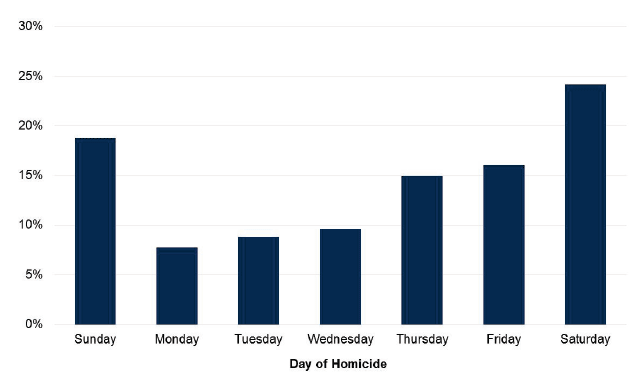
Comparator statistics
- This bulletin has shown a decreasing trend in homicides. To help validate these findings, we look at other comparable sources of data.
- Chart 11 shows other recorded crimes taken from Recorded Crime in Scotland, 2014-15 bulletin (including attempted murder and serious assault). The number of recorded homicides by the police has followed a downward pattern over the ten year period from 2005-06 to 2014-15 comparable to the number of attempted murders and serious assaults.
Chart 11: Indices in selected crimes of violence, Scotland, 2005-06 to 2014-15 (Index 2005-06 = 100)
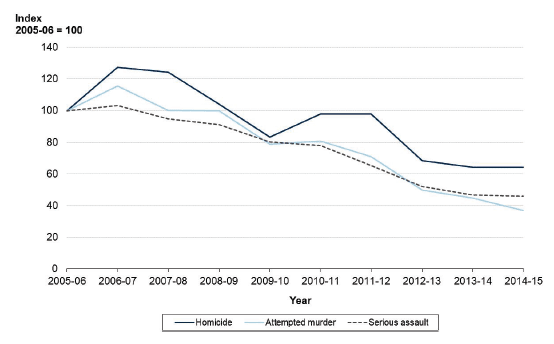
- Chart 12 uses an index to evaluate the trends in the victimisation rates in Scotland and England & Wales[2] between 2005-06 and 2014-15 (Note that 2014-15 England & Wales data are not yet available). This does not compare homicide rates between Scotland and England & Wales, due to uncertainty around different counting conventions. The data do demonstrate that both Scotland and England & Wales are showing comparable downward trends in the ten-years leading up to 2014-15.
Chart 12: Change in the victimisation rate in Scotland (2005-06 to 2014-15) and England and Wales (2005-06 to 2013-14)
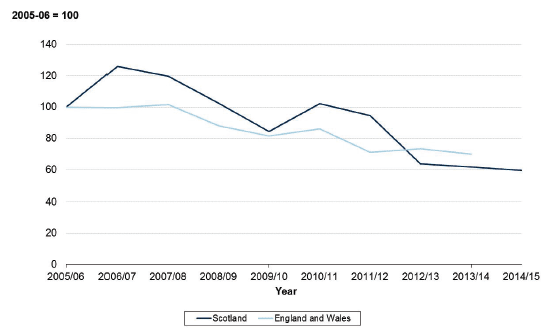
Contact
Email: Alastair Greig
There is a problem
Thanks for your feedback